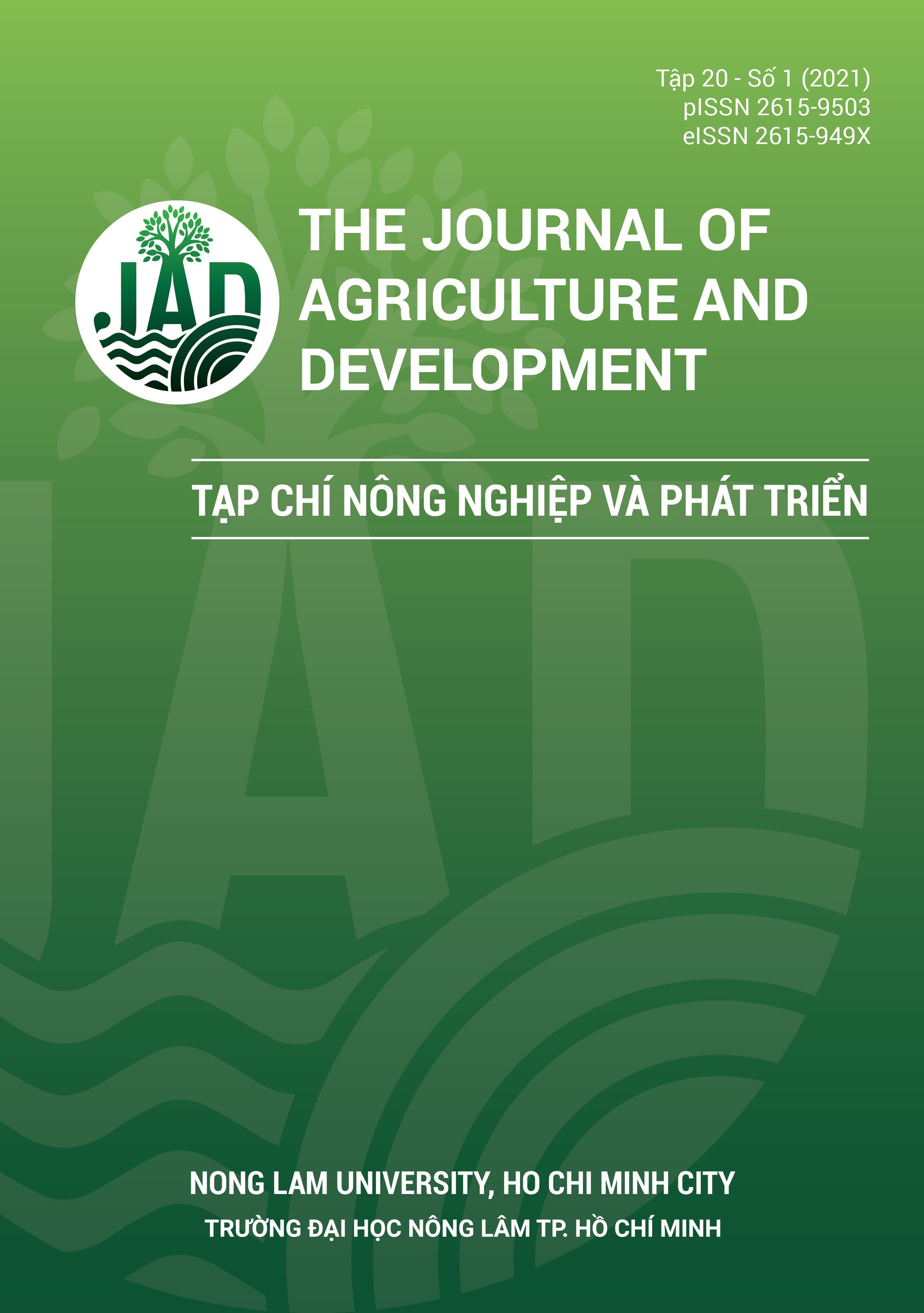Release kinetics of lime essential oil (Citrus aurantifolia) from beads microencapsulated through ion-gel method
Main Article Content
Abstract
Ca-Alginate beads for microencapsulation of lime oil (Citrus aurantifolia) by ion-gel method was manufactured and then soaked in Chitosan solution to obtain Ca-Alginate-Chitosan beads. Increased CaCl2 concentrations reduced lime essential oil release. The alginate concentration (2 to 3%) and water temperature affected significantly the release of oil (P< 0.05). The higher temperatures, the higher the release rate. The oil release at 75oC was twice as much as at 45oC. At 45oC, the difference in the release rate among the alginate concentrations of 2%, 2.5% and 3% was clear and statistically significant (P< 0.05). However, at 60oC and 75oC, there was no significant difference in release between the alginate concentration of 2.5% and 3% (P > 0.05). In the storage of beads in 1% CaCl2 solution at normal temperature, after the first 15 days, Ca-Alginate-Chitosan system released about 3% slower than Ca-Alginate system, but there was no difference between the two systems after 45 days. This shows that if prolonged for a long time, the ion-gelation of Ca-Alginate prevails over the Alginate-Chitosan cross-link.
Article Details
References
Anitha, K., Ramachandran, T., Rajendran, R., & Mahalakshmi, M. (2011). Microencapsulation of lemon grass oil for mosquito repellent finishes in polyester textiles. Elixir International Journal 40, 5196-5200.
Douglas, K. L., & Tabrizian, M. (2005). Effect of experimental parameters on the formation of alginate–chitosan nanoparticles and evaluation of their potential application as DNA carrier. Journal of Biomaterials Science, Polymer Edition 16(1), 43-56. https://doi.org/10.1163/1568562052843339
Fundueanu, G., Nastruzzi, C., Carpov, A., Desbrieres, J.,& Rinaudo, M. (1999). Physico-chemical characterization of Ca-alginate microparticles produced with different methods. Biomaterials 20(15), 1427-35. https://doi.org/10.1016/S0142-9612(99)00050-2
Kausadikar, S., Ashish, D. G., & Jyotsna, W. (2015). Microencapsulation of lemon oil by spray drying and its application in flavour tea. Advances in Applied Science Research 6(4), 69-78.
Martins, I. M., Maria, F. B., Manuel, C., & Alírio, E. (2014). Microencapsulation of essential oils with biodegradable polymeric carriers for cosmetic applications. Chemical Engineering Journal 245, 191-200. https://doi.org/10.1016/j.cej.2014.02.024
Park, S. J., Shin, Y. S., & Lee, J. R. (2001). Preparation and characterization of microcapsules containing lemon oil. Journal of Colloid and Interface Science 241(2), 502-508. https://doi.org/10.1006/jcis.2001.7727
Peng, H., Xiong, H., Li, J., Xie, M., Liu,Y., Bai, C., & Chen, L. (2010). Vanillin cross-linked chitosan microspheres for controlled release of resveratrol. Food Chemistry 121(1), 23-28. https://doi.org/10.1016/j.foodchem.2009.11.085
Silva, E. K., Giovani, L. Z., Angela, M., & Meireles, A. (2015). Ultrasound-assisted encapsulation of annatto seed oil: Retention and release of a bioactive compound with functional activities. Food Research International 78, 159-168. https://doi.org/10.1016/j.foodres.2015.10.022
Soliman, E. A., El-Moghazy, A. Y., El-Din, M. S. M.,& Massoud, M. A. (2013). Microencapsulation of essential oils within alginate: Formulation and in vitro evaluation of antifungal activity. Journal of Encapsulation and Adsorption Sciences 3(1), 48-55. https://doi.org/10.4236/jeas.2013.31006
Truong, V. (2020). Effectiveness of liquid jet breakup and jet cutting systems used in microencapsulation processes of cosmetics, pharmaceuticals and foods (Report of Project B2018-NLS13 funded by the Ministry of Education and Training of Vietnam). Nong Lam University, Ho Chi Minh City, Vietnam.
Truong, V., Nguyen, P. T., Ta, P. N. M., Nguyen, P. T., & Pham, N. T. C. (2020). Effects of type and concentra-tion of alginate on microencapsulation characteristics of lime essential oil (Citrus aurantifolia) produced by extrusion-dripping methods. The Journal of Agriculture and Development 19(1), 65-76.
Weinbreck, F., Minor, M., & de Kruif, C. G. (2004). Microencapsulation of oils using whey protein/gum arabic coacervates. Journal of Microencapsulation 21(6), 667-679. https://doi.org/10.1080/02652040400008499








